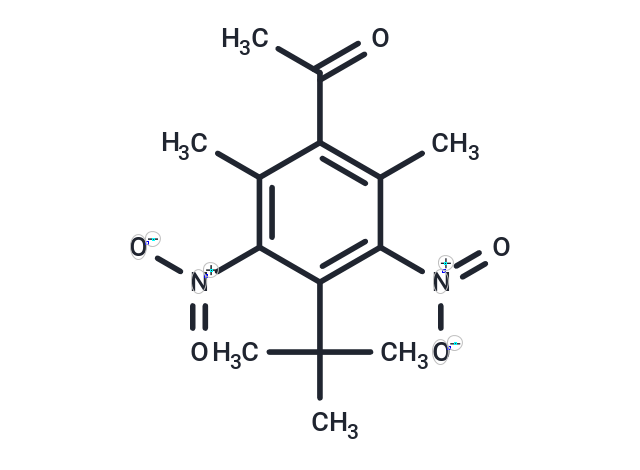Shopping Cart
- Remove All
 Your shopping cart is currently empty
Your shopping cart is currently empty

Musk ketone can induce the growth repression and the apoptosis of cancer cells. Musk ketone increases activity of glutathione S-transferase and thus may prove to be useful cancer chemoprotectant.

| Pack Size | Price | Availability | Quantity |
|---|---|---|---|
| 100 mg | $31 | In Stock | |
| 500 mg | $70 | In Stock | |
| 1 g | $98 | In Stock | |
| 5 g | $236 | In Stock | |
| 10 g | $348 | In Stock |
| Description | Musk ketone can induce the growth repression and the apoptosis of cancer cells. Musk ketone increases activity of glutathione S-transferase and thus may prove to be useful cancer chemoprotectant. |
| In vitro | Similar to native musk, synthetic musk ketone induced the growth repression and the apoptosis of cancer cells. Additionally, numerous genes were differentially expressed in lung cancer cells after native musk treatment. These differentially expressed genes were involved in many signalling pathways. Among these pathways, apoptosis-related pathways included interleukin family, tumor necrosis factor family, and MAPK signalling pathway. Native musk and synthetic musk ketone can up-regulate IL-24 (interleukin family) and DDIT3 (MAPK signalling pathway) in lung cancer cells[1]. |
| In vivo | Musk ketone can reduce secondary damage after spinal cord injury and promote nerve recovery in rats[2]. |
| Cell Research | Twenty two cancer cell lines were treated with musk. Cell proliferation and apoptosis analyses were carried out. Native musk and synthetic?musk ketone?were analyzed by gas chromatograph-mass spectrometer (GC-MS) assay. Differentially expressed genes were determined by microarray and quantitative real-time polymerase chain reaction. |
| Animal Research | The rats weighed from 200 to 250 g and ?were randomly divided into five treatment groups: saline (NS group), methylprednisolone (MP group), and musk ketone groups (MO1, MO2, and MO3 groups).?The Swash plate test and BBB behavioral score were used to determine neurological function recovery after spinal cord injury.?Hematoxylin-eosin (HE) staining was used to detect general structural changes in spinal cord tissue.?The enzyme-linked immunosorbent assay was used for the determination of interleukin 10 (IL-10) in spinal cord tissue.??Compared with the NS control group, critical angle, BBB score and IL-10 levels in rat spinal cord tissue significantly increased in the MP group and MO groups 7 and 14 days after the operation.?HE staining showed that in the NS group, there was hemorrhage, edema, necrosis, axonal demyelination, inflammatory cell infiltration and glial cell response in spinal cord tissue.?After 7 days, spinal cord edema and inflammation were reduced and neuronal degeneration and necrosis were not evident in the MP and MO groups[2]. |
| Molecular Weight | 294.3 |
| Formula | C14H18N2O5 |
| Cas No. | 81-14-1 |
| Smiles | CC(=O)c1c(C)c(c(c(c1C)[N+]([O-])=O)C(C)(C)C)[N+]([O-])=O |
| Relative Density. | 1.206 g/cm3 |
| Storage | Powder: -20°C for 3 years | In solvent: -80°C for 1 year | Shipping with blue ice. | ||||||||||||||||||||||||||||||
| Solubility Information | DMSO: 25 mg/mL (84.95 mM), Sonication is recommended. | ||||||||||||||||||||||||||||||
Solution Preparation Table | |||||||||||||||||||||||||||||||
DMSO
| |||||||||||||||||||||||||||||||

Copyright © 2015-2025 TargetMol Chemicals Inc. All Rights Reserved.